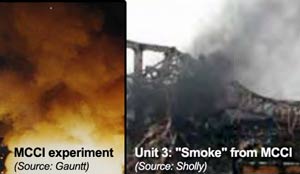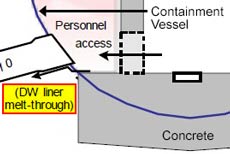
US Gov’t: Melted fuel most likely burned through containment at Fukushima reactors; We’re concerned about failures underground… “Where did it leak out? How did it leak out? We don’t know” — Expert: Corium may have flowed into reactor buildings, burned through floor (PHOTOS & AUDIO)
ENE News
Brian Sheron, Office Director of Nuclear Regulatory Commission’s Office of Nuclear Regulatory Research, NRC’s 2013 Regulatory Information Conference (emphasis added): Aqueous release occurred during Fukushima accident… Current models do not address aqueous release pathways… [NRC's Office of Nuclear Regulatory Research] is starting a program to assess: Containment failure modes that could lead to aqueous releases; Source term modeling for aqueous pathways; Transport of contaminated water and its radiological consequences…
Sheron, Part I
(6:15 in): “Another area that we’re looking at — it’s not really part of the ‘Post-Fukushima Lessons Learned’ — it’s aqueous pathways. One of the things we saw — and it was because most likely perhaps containment failure and liner melt-through — that there was contaminated water that was released to the environment into the ground. And the question is, how does that water behave once it’s released? How does it find its way to other waterways? What kind of doses might be expected from that? We’re just starting right now to do some work in that area.”
Sheron, Part II (11:45 in): “There was actually aqueous releases at Fukushima… The question is: Where did it leak out? How did it leak out? We don’t know yet. Speculation is… the core melt probably went down into the drywell, spread, and perhaps burned through the liner, which will provide a release path… The question now is: if there are aqueous release paths during a severe accident, what are the consequences? What we’re planning on looking at, at least — we haven’t started — is to first look at containment failure modes: Did we miss anything? Are there containment failure modes — that could occur below grade, you might say [Below grade: The portion of a building that is below ground level] — where water could leak out? The source term modeling for the aqueous pathways. Then the transport of that contaminated water, and the radiological consequences. How does it get into surface water? Does it stay in ground water? And what are the radiological doses… downstream? The expectation is, we’ll get a better feel for what the safety concern is with that, and whether any further actions are needed.”
Randall Gauntt, Manager of Sandia National Laboratories’ Severe Accident Analysis Dept., NRC’s 2013 Regulatory Information Conference (15:00 in): “You can see core materials dropping down… about 90 tons of core material to the  cavity region. When that material hits the cavity, core concrete interaction starts up. This is a picture from an experiment where we’re looking at core-concrete interaction. To give you an idea, once it hits the floor, more bad stuff happens — here you see what core-concrete interaction looks like.”
cavity region. When that material hits the cavity, core concrete interaction starts up. This is a picture from an experiment where we’re looking at core-concrete interaction. To give you an idea, once it hits the floor, more bad stuff happens — here you see what core-concrete interaction looks like.”
Steven C. Sholly, Senior Scientist, Institute of Safety and Risk Sciences: Fukushima Accident Progression — Core debris… attacks the concrete on the drywell floor [and] can contact the drywell shell… in the absence of water on the drywell floor, melt-through of the drywell shell is likely… [I]t is possible for core debris… to flow into the vent pipes, melt through them, and deposit on the lowest level of the reactor building… “Molten Corium/Concrete Interaction” (MCCI) can take place in both the drywell and the reactor building.
Conference Recordings: Sheron I | Sheron II | Gauntt
Published: May 28th, 2015 at 2:30 pm ETBy ENENews |

